The Acropolis of Athens Old Museum
IntroductionThe Museum existing until lately on the Acropolis rock was considered among the most important ones in the world and definitely the most important one as far as the History of European Art is concerned. It was built on the Acropolis Hill in 1874, in such a way that it would not aesthetically interfere with the Temples, nor be visible from anywhere within the city of Athens.
The excavations that followed, toward the end of the 19th century, unearthed a wealth of finds which were impossible to exhibit in the limited space of the Museum. Thus, the inscriptions, bronzes, clay objects, and a variety of other items were kept in the National Archaeological Museum, where they were originally taken for conservation. The situation was aggravated after all the marble pieces were removed from the Parthenon Friezes (that is, what was left over after Elgin's plunder) and were put in the museum, together with the Caryatids (the marble statues of the women supporting the roof of the south porch of the Erechtheion), all of which were removed to be kept in an air-tight window containing nitrogen, so as to stop air pollution from deteriorating the marble surfaces.
The collections of the museum included:
Sculptural offerings of the Archaic period
Pediments of temples dated to the Archaic period
Archaic Horsemen
Sculptures of the "Severe" style
Pediments and metopes from the Parthenon
The Parthenon frieze
The Erechtheion frieze
Parapets of the Athena Nike temple
Frieze of the Athena Nike temple
The Caryatids
Clay figurines and vases from the sanctuary of the Nymphs.
Everyone was eagerly anticipating the completion of the new Acropolis Museum, for the total wealth of finds related to the Acropolis and the Parthenon to finally be exhibited in the best possible way (combining location, lighting, space, air filtering and thematic consistency), and thus deprive the descendants of Lord Elgin of all plausible excuses to insist that the Parthenon Marbles continue to be kept separated from the rest of their like and the Parthenon remain in its mutilated state.
During 2008, the exhibits of this Museun were transferred to the New Museum, the erection of which was completed. Three huge cranes were used to carry all the heavy marble statues and exhibits, a total of some 4,500 artifacts from the old, cramped Acropolis museum, a task that was the biggest airlift of antiquities in Greek history. It was the first time the artifacts — some of which are considered among the most important works of antiquity — were moved from the very Acropolis Rock. This transfer was completed in the end of spring but putting up the exhibits in their right place would take a lot longer.
We thought that the present Album would become useless after the New Museum's inauguration. Nevertheless, the decision of the museum authorities to prohibit taking photographs of the exhibits in their new surrounding created more problems than the ones it was supposed to solve. We admit that the decision was well meant, but, with all due respect, we would like to point out that times have changed; we are afraid that whatever is not shown online cannot achieve the level of promotion that it may be worthy of. We managed, though, to get a number of photos of the exhibits, as the decision was taken a couple of weeks after the museum's inauguration. We are working on them and will do our best to put them up as soon as possible. But, in our effort to best present the exhibits, we are sorry to have to use some of the photos taken at the Old Acropolis Museum. Until the New Acropolis Museum album is online, please enjoy the marvellous artifacts at their old "home".
(Photos: Michael Tziotis)
Select Page of the Album:
Click on any of the pictures to enlarge.
Gallery IIIPediment with two lions tearing apart a bull and Korae of the island workshops around 570 - 560 BC.
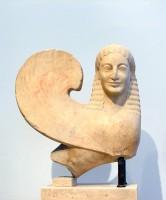
Akr 632. Statue of a Sphinx
Statue of a sphinx turning her head to her right, in distinction to the sphinx Akr 630 (Gallery II) facing straight ahead; Probably the corner akroterion of an archaic temple. In front, her wavy hair falls to her shoulders; in back, the hair is rendered as chains of beads. Vivid color preserved on the feathers. Attic work dated to 540-530 B.C. |
|
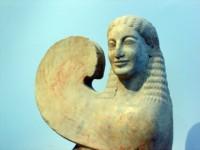
Akr 632. Statue of a Sphinx
Another photo of the Sphinx sculpture |
|
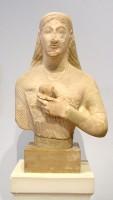
Akr 677. The upper part of a Kore
The upper part of a Kore made of Naxian marble. Her left arm is bent across her breast and her left hand is holding an apple, offering to the goddess. The marble quality, the style of her garment and the type of hair-do attest for her island origin. Made in a Naxian workshop, around 570-560 B.C. |
|
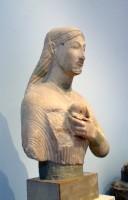
Akr 677. The upper part of a Kore |
|
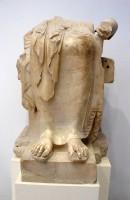
Akr 618. Statue of an enthroned goddess
Preserved from below the waist down, together with a part of the left arm adorned with a bracelet. The throne and footstool were painted red. The figure wears a thin chiton, which the left hand pulls to the side. The central fold has a meander pattern and squares filled with stars; the pattern continues on the left knee and on the sleeve. She wears an Ionic himation over the chiton. The drapery and skin have been worked to a remarkably smooth finish. From an Attiv workshop, around 520 B.C. |
|
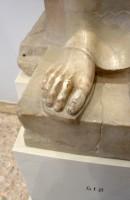
Akr 618. Statue of an enthroned goddess (Foot Detail) |
|
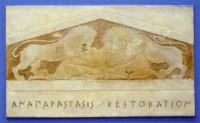
Akr 003. Restoration of the Two Lions and a Bull Pediment
Porous limestone pediment depicting two lions devouring a bull. The composition decorated the Hecatompedon (the Earliest Parthenon?) and probably was placed between the Triton and the Tree-bodied Daemon (pediments Akr 36-35, Gallery II). The body and the expression of the dying animal is remarkably rendered. The colors, red, blue or green and the engraved or colored details are excellently preserved. Second quarter of the 6th century BC. |
|

Akr 003. Two Lions and a Bull Pediment
Please scroll to see the whole of it |
|
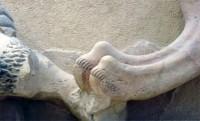
Akr 003. Two Lions and a Bull Pediment (Detail) |
|
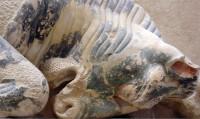
Akr 003. Two Lions and a Bull Pediment (Detail) |
|
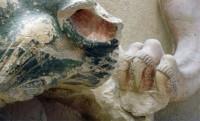
Akr 003. Two Lions and a Bull Pediment (Detail) |
|
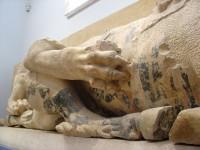
Akr 003. Two Lions and a Bull Pediment (Detail) |
|
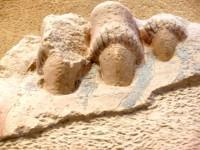
Akr 003. Two Lions and a Bull Pediment (Detail) |
|
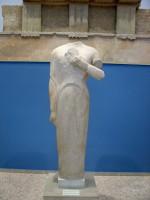
Akr 619. Statue of a Kore. Naxian marble. Ionic island workshop. Around 570 BC. |
|
Select Page of the Album:
|
|



